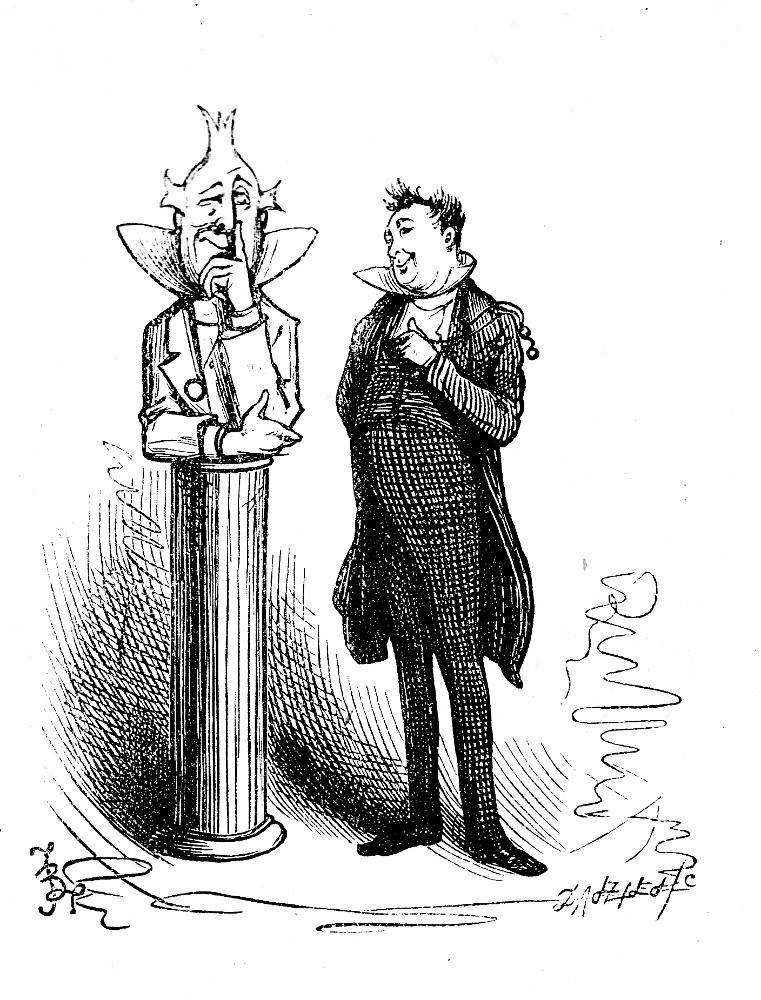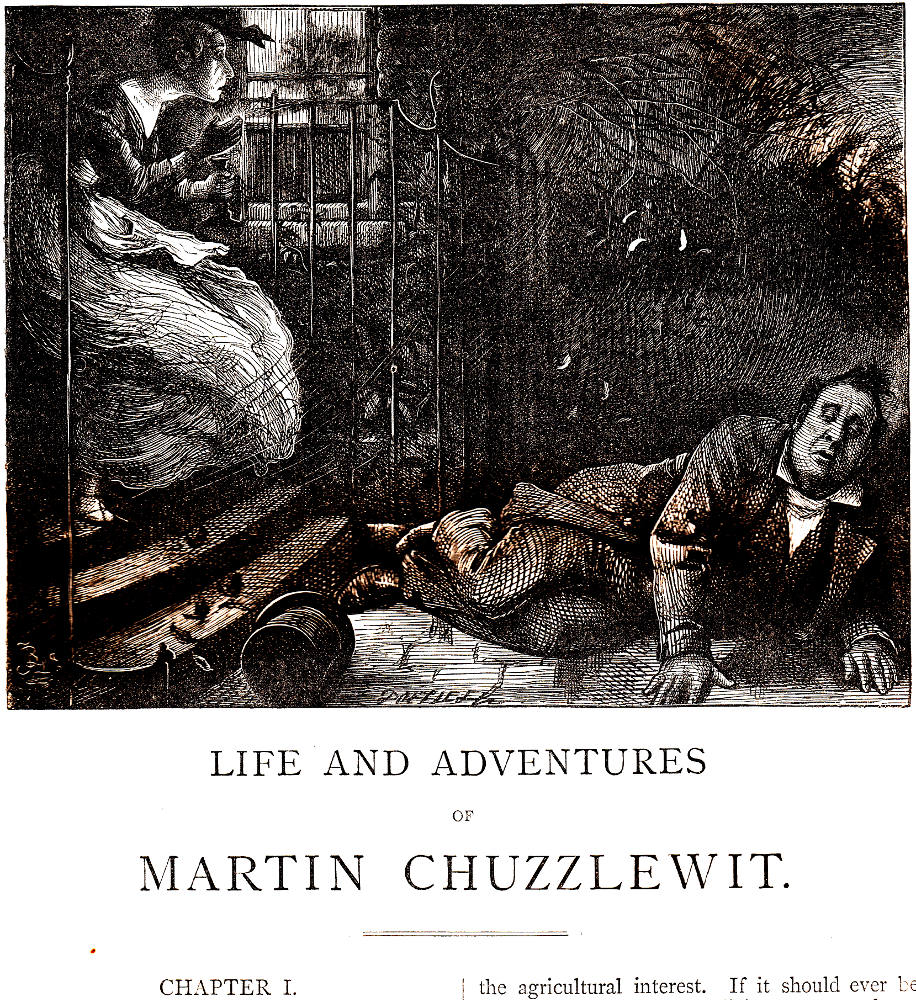Seth Pecksniff
Fred Barnard
1884
11.1 x 9 cm framed
One of six lithographs in A Series of Character Sketches from Dickens, from the Original Drawings by Frederick Barnard. . .. Series 2: Tony and Sam Weller; Caleb Plummer and his blind daughter, Bertha; Little Nell and her grandfather, and Rogue Riderhood, Dan'l Peggotty, and Seth Pecksniff. (1884).
"Perhaps there never was a more moral man than Mr. Pecksniff especially in his conversations and correspondence . . . He was a most exemplary man; fuller of virtuous precept than a copybook. Some people likened him to a direction-post, which is always telling the way to a place, but never goes there." — Chapter II, "Wherein Certain Persons are Presented to the Reader, with Whom He May, If He Please, Become Better Acquainted." [Click on the illustration to enlarge it.]
Scanned image and text by Philip V. Allingham. [See below for commentary, and mouse over the text for links.]
Passage Complemented
It has been remarked that Mr. Pecksniff was a moral man. So he was. Perhaps there never was a more moral man than Mr Pecksniff, especially in his conversation and correspondence. It was once said of him by a homely admirer, that he had a Fortunatus’s purse of good sentiments in his inside. In this particular he was like the girl in the fairy tale, except that if they were not actual diamonds which fell from his lips, they were the very brightest paste, and shone prodigiously. He was a most exemplary man; fuller of virtuous precept than a copy book. Some people likened him to a direction-post, which is always telling the way to a place, and never goes there; but these were his enemies, the shadows cast by his brightness; that was all. His very throat was moral. You saw a good deal of it. You looked over a very low fence of white cravat (whereof no man had ever beheld the tie for he fastened it behind), and there it lay, a valley between two jutting heights of collar, serene and whiskerless before you. It seemed to say, on the part of Mr. Pecksniff, ‘There is no deception, ladies and gentlemen, all is peace, a holy calm pervades me.’ So did his hair, just grizzled with an iron-grey which was all brushed off his forehead, and stood bolt upright, or slightly drooped in kindred action with his heavy eyelids. So did his person, which was sleek though free from corpulency. So did his manner, which was soft and oily. In a word, even his plain black suit, and state of widower and dangling double eye-glass, all tended to the same purpose, and cried aloud, ‘Behold the moral Pecksniff!’
The brazen plate upon the door (which being Mr Pecksniff’s, could not lie) bore this inscription, ‘PECKSNIFF, ARCHITECT,’ to which Mr Pecksniff, on his cards of business, added, AND LAND SURVEYOR.’ In one sense, and only one, he may be said to have been a Land Surveyor on a pretty large scale, as an extensive prospect lay stretched out before the windows of his house. Of his architectural doings, nothing was clearly known, except that he had never designed or built anything; but it was generally understood that his knowledge of the science was almost awful in its profundity. [Chapter II, "Wherein Certain Persons are Presented to the Reader, with Whom He May, If He Please, Become Better Acquainted."]
Commentary: A Question of Emphasis
‘This,’ said Mr Pecksniff, opening the door of an opposite parlour, ‘is the little room of state, I mentioned to you. My girls have pride in it, Martin! This,’ opening another door, ‘is the little chamber in which my works (slight things at best) have been concocted. Portrait of myself by Spiller. Bust by Spoker. The latter is considered a good likeness. I seem to recognize something about the left-hand corner of the nose, myself.’ — Chapter V, "Containing a Full Account of the Installation of Mr. Pecksniff's New Pupil into the Bosom of Mr. Pecksniff's Family. With All the Festivities Held on that Occasion and the Great Enjoyment of Mr. Pinch."
Whereas the original Phiz and Barnard illustrations involving the Wiltshire architect, Seth Pecksniff, are realisations of specific moments in Dickens's Martin Chuzzlewit, this portrait of Pecksniff in his study is attached to no one moment in the text. For example, although the pose that Barnard has him strike is certainly characteristic of the hypocritical egotist, Barnard shows him with none of his usual adherents such as his daughters, and has included both the oil portrait by Spiller and the marble bust by Spoker, although neither of these figures in Dickens's initial description of Pecksniff. And whereas Dickens introduces the Pecksniff sisters in Chapter 2, he does not describe either the Spiller oil portrait or the Soker bust until Chapter 5, in the second monthly part. Barnard, realising that these emblematic details define the egotist, included the bust in the title-page vignette of Pecksniff, in love (as it were) with himself in the 1872 Household Edition volume. These revealing elements first appear in Phiz's Mr. Pinch and the New Pupil, on a Social Occasion in Chapter 5, in Pecksniff's study, among his many architectural studies on the wall and above the mantlepiece, looming over Tom Pinch and young Martin Chuzzlewit.
There is far more to Barnard's rethinking of Pecksniff as a mere "platitudinous hypocrite" (Schlicke, 369) in this full-length colour portrait of the professional man in his study. But Barnard's task is larger here than it was in the Household Edition since has no text to support or upon which to elaborate: there is no amusing Dickens commentary about the humorous character's "smooth self-righteousness" and "conspicuous puritanism" (Slater, 208). Barnard still has that laughable name, of course: "suggestive as it is both of carping criticism and supercilious disapproval" (Slater, 208). And he could probably rely in the 1880s upon a body of readers intimately familiar with the trajectory of the arch-hypocrite, whose oily loquacity and moral veneer nearly result in his marrying Mary Graham and becoming Old Martin's heir. Here, then, every detail matters in the artist's visual summary of the pernicious but persuasive hypocrite: the room bespeaks his aspiration to professional status, although Barnard is far more sparing here with the architectural studies that surround Pecksniff in earlier narrative-pictorial sequences. The centrepiece, however, is not a church or a grammar school, but a pump, the centre of a community and its chief source of drinking water in the time of cholera. The drafting of something so eminently practical and lacking in Pecksniffian grandiosity is the assignment he sets his new pupil: "A pump . . . is very chaste practice."
Introductory Scenes involving Mr. Pecksniff: 1843, 1867, 1872, and 1910



Left: Sol Eytinge, Jr.'s 1867 study of the complacent Pecksniff and his plain and pretty daughters, Pecksniff and hgis Daughters (Chapter 2, Diamond Edition). Centre: Harry Furniss's realisation of the scene in which the family effusively welcomes Martin, The Pecksniffs posing to receive Martin (1910). Right: Fred Barnard's characterisation of Pecksniff as endearingly vain, Uncaptioned title-page vignette (1872). [Click on the images to enlarge them.]


Left: Phiz's original introductory plate for the Pecksniff family and Tom Pinch, the apprentice: Meekness of Mr. Pecksniff and his charming daughters (Chapter II, January 1843 Right: ).Fred Barnard's realisation of the novel's opening scene, with Pecksniff blown down on his own steps, Uncaptioned illustration to begin Chapter One (1872).
Related Materials
- Seth Pecksniff, Architect
- Illustrations by Sol Eytinge, Jr. (16 plates from the Ticknor and Fields' Diamond Edition of 1867)
- Fred Barnard (60 plates from the Chapman and Hall Household Edition of 1872)
- Clayton J. Clarke (five studies from three sources, 1910)
- Harry Furniss (twenty-eight lithographs for the Charles Dickens Library Edition, 1910)
- Harold Copping's 1924 coloured lithographic study: Mr. Pecksniff and Old Martin Chuzzlewit
You may use these images without prior permission for any scholarly or educational purpose as long as you (1) credit the person who scanned them (Philip Allingham) and (2) link your document to this URL in a web document or cite the Victorian Web in a print one.
Bibliography
Dickens, Charles. Martin Chuzzlewit, with 60 illustrations by Fred Barnard. Household Edition. 22 vols. London: Chapman and Hall, 1872. Vol. II.
A Series of Character Sketches from Dickens, from the Original Drawings by Frederick Barnard, Being Facsimiles of Original Drawings by Fred. Barnard. Series 2: Tony and Sam Weller; Caleb Plummer and his blind daughter, Bertha; Little Nell and her grandfather, and Rogue Riderhood, Dan'l Peggotty, and Seth Pecksniff. London: Cassell, Petter, and Galpin, 1884.
Schlicke, Paul (ed.). "Martin Chuzzlewit." Oxford Readers' Companion to Dickens. Oxford: Oxford U. P., 1999. Pp. 366-371.
Slater, Michael. ";The Turning-point of His Career': England, Italy, England, 1842-1845." Charles Dickens. New Haven and London: Yale U. P., 2009. Pp. 207-240.
Victorian
Web
Illustration
Fred
Barnard
Character
Sketches
Next
Created 29 January 2025
